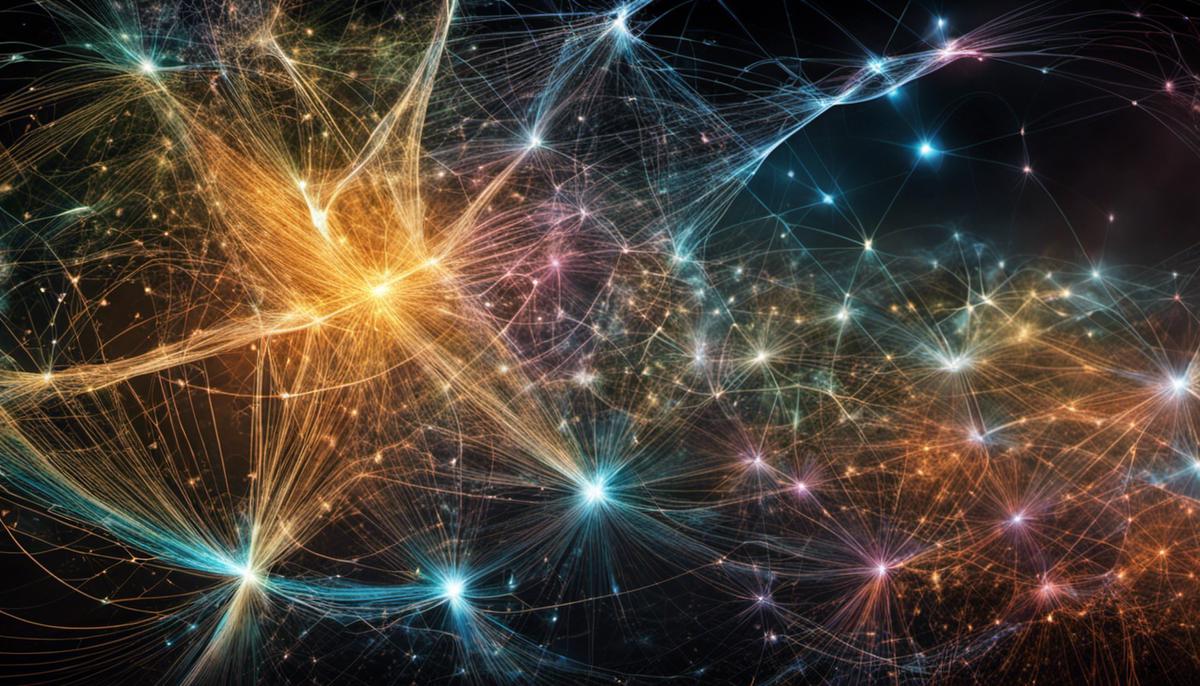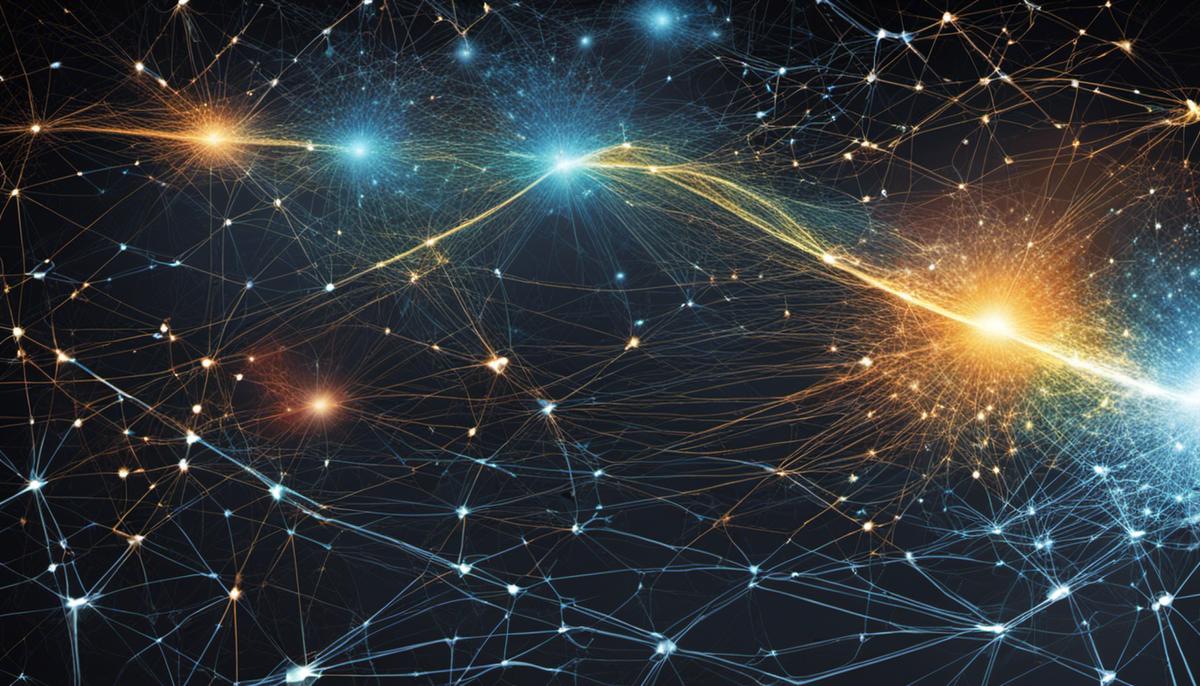A fascinating journey into the world of quantum network architectures awaits as we explore the intricacies of basic laws of quantum physics and their implementation and usage in quantum networking. We will focus on principles such as superposition and entanglement, which are the cornerstones of quantum networks. We will also decode complex scientific terms associated with quantum networks to ensure a comprehensive understanding. In addition to providing a clear explanation of quantum protocols and routing methodologies, we will delve into the essence of Quantum Key Distribution (QKD) methods and the role of quantum repeaters in transferring quantum data over long distances.
Basics of Quantum Networking
Title: Foundations of Quantum Networking: Principles and Concepts
The emergence of quantum networking is the result of numerous scientific breakthroughs in the field of quantum physics, promising transformative applications in fields such as secure information transfer, efficient problem-solving, and complex simulations. To fully grasp this complex subject, it’s crucial to understand its foundational principles and concepts.
Quantum networking, at its core, operates under the principles of quantum mechanics. This oft-misunderstood field deals with phenomena on a microscopic scale, primarily involving particles such as photons or electrons.
1. Quantum Superposition:
The first principle to understand is superposition, an inherently quantum mechanical phenomenon. Superposition dictates that particles exist in all possible states simultaneously until observed. This concept enables quantum bits, or qubits, to exist in a state of 0 and 1 concurrently, vastly expanding computational possibilities beyond classical binary states.
2. Quantum Entanglement:
Quantum entanglement uncovers the profoundly interconnected nature of quantum particles. In this state, pairs or groups of particles become entwined, such that the state of one cannot be described independently of the state of the other(s), even across vast distances. This bond forms the crux of quantum networking, facilitating instantaneous information transfer, arguably making quantum networks more efficient and secure than their classical counterparts.
3. Quantum Tunneling:
Another fundamental principle, quantum tunneling, allows particles to pass through barriers that would normally be impassable according to classical physics. This feature could potentially revolutionize data transfer rates, as particles will seemingly bypass physical hindrances during transmission.
Among these principles, the practical implementation of quantum networking draws upon crucial concepts like quantum-keys distribution (QKD) and quantum repeaters.
4. Quantum-Key Distribution (QKD):
QKD is a protocol for the secure communication of classical information by utilizing the principles of quantum mechanics. Here, quantum superposition and entanglement ensure the security of key exchange, enabling the detection of eavesdroppers. If an outside entity attempts to intercept the key, the quantum state of the information would collapse, thus revealing the intrusion.
5. Quantum Repeaters:
Just as classical networks utilize repeaters to amplify signal strength over long distances, quantum networks employ quantum repeaters to restore entangled states that have decohered due to loss or noise. Quantum repeaters combat the inherent fragility of quantum states and are essential for the creation of long-distance quantum networks.
Quantum networking beckons a new era in information technology, promising advancements in secure communication, quantum computing, and quantum simulation. The comprehension of these foundational principles and concepts is a significant stride towards understanding the operations of these networks and, thereby, the realization of quantum technologies’ immense potential.

Quantum Routing and Protocols
Quantum Routing Protocols: Key Mechanisms for Secure and Efficient Networks
Delving deeper into the complex and fascinating arena of quantum mechanics, particularly in its application to communications technology, involves a focus on quantum routing methods and their relevance to network security and efficiency. Specifically, we turn our attention to Quantum Teleportation and Quantum Trajectory Methods (QTMs), decoding the hidden potentials within Quantum Cryptography and quantum state engineering via Quantum Error Correction Codes (QECC).
Quantum Teleportation, a fundamental method in the quantum realm, is a non-traditional transfer process where the state of a quantum entity is instantaneously replicated in another location without traveling through physical space. This technique outshines the conventional data exchange methods by offering a faster and more secure process. Unlike classical teleportation, Quantum Teleportation relies on quantum entanglement, transporting information without ever exposing it, hence making it highly secure against eavesdroppers.
However, Quantum Teleportation, in its current progress, can only transmit a handful of quantum states (qubits), limiting its use. Here, Quantum Trajectory Methods step in. They enhance the transfer capacity, optimally managing the transfer of multiple quantum states. The key advantage of QTMs lies in their ability to predict the movement of quantum states, allowing for streamlined quantum routing between multiple nodes and enabling efficient quantum communication over larger networks.
Closely associated with these quantum routing strategies, Quantum Cryptography holds a key role in structuring a secure quantum network. Primarily through a model known as Quantum Key Distribution (QKD), Quantum Cryptography ensures that keys for encoding and decoding information are securely exchanged, rendering any intent to intercept virtually impossible.
Nevertheless, quantum systems are known for their susceptibility to environmental interferences, a factor that can compromise the integrity of transmitted quantum states despite our advancements in quantum routing and cryptography. To counteract these nuisances, quantum state engineering utilizes Quantum Error Correction Codes (QECC). These codes endeavor to identify and rectify errors in quantum states, protecting the information and ensuring its coherent transfer.
In conclusion, Quantum Teleportation, Quantum Trajectory Methods, Quantum Cryptography, and quantum state engineering are pivotal components in the realm of quantum routing. Each brings unique solutions to the challenges that this emerging technology encounters, offering distinct methods to secure and enhance the efficiency of quantum networks. As this thrilling realm of quantum communications continues to unfold, the exploration and mastery of quantum routing protocols and methods become even more critical in shaping the future of quantum networks and the transformation they promise to deliver in global communications.

Existing Quantum Network Models
Evolutionary Paradigms and Current Models of Quantum Networks
In the vast expanse of modern scientific exploration, quantum networks have emerged as a pivotal research area with profound implications for the future of information transfer and encryption. Understanding the various models of quantum networks and their evolutionary trajectory is thus paramount to the comprehension and application of quantum networking.
Building on the unshakeable foundations of quantum theory—namely quantum superposition, entanglement, tunneling, and the nuances of quantum-key distribution (QKD) and quantum repeaters—the complexity of quantum networks has grown exponentially over the years. As new phenomena emerged and existing ones were refined, a variety of models took form, each with its unique methodologies and implications.
One technique that has become indispensable in quantum networking models is Quantum Teleportation. The phenomenon of quantum teleportation diverges from traditional transmission mechanisms by leveraging quantum entanglement to transfer quantum states over vast distances. By exploiting this property, quantum networks become exponentially more efficient and secure than classical networking models, creating a promising avenue for global communication.
As quantum information science progressed, Quantum Trajectory Methods (QTMs) found impactful applications in quantum networking models. QTMs provide robust dynamical equations for the explicit tracking of quantum evolution, enabling a more efficient manipulation of quantum states and, by extension, quantum networks.
Quantum Cryptography applies quantum principles to bolster security in network models. Leveraging the distinct attributes of quantum information, particularly key distribution (QKD), it allows for perfectly secure communication that cannot be infiltrated without detection. This unparalleled level of security marks it out as a game-changer for future network models.
Over time, Quantum Error Correction Codes (QECC) have also emerged as a cornerstone in quantum network models. These codes ensure the stable transmission of quantum data and protect quantum states from errors occurring due to environmental interactions or imperfect quantum gate operations. This evolution of QECC underlines the maturation and resilience of quantum networks.
The concept of quantum state engineering has sparked notable advancements in network models, particularly in quantum routing. Quantum state engineering, despite the challenges it poses, has enabled the construction of desired states in quantum systems. This facilitates the efficient routing of information and the creation of optimized quantum networks.
Suffice it to say while quantum networks are a relatively nascent field, marked by ongoing research and unresolved challenges, they promise immense potential, not just for global communications but across various spheres of human endeavor. The evolution of quantum networks from rudimentary QKD to advanced quantum state engineering signals a remarkable transition in scientific endeavor, and the dance of intellect played on the edge of the quantum world. To fully understand these marvels and harness their inherent power, one must delve deeper, learn continuously, and revel in the entangled complexities of quantum networks. The destiny of information technology lies partially deciphered in these enigmatic quantum realms, inviting us to unlock their secrets.

Challenges & Future Directions
Beyond the concepts of quantum superposition, entanglement, tunneling, quantum-key distribution (QKD), quantum repeaters, quantum teleportation, quantum trajectory methods (QTMs), quantum cryptography, quantum error correction codes (QECC), and quantum state engineering, lie challenges intrinsic to the realm of quantum networking. These challenges oftentimes involve quantum routing and potential applications of quantum networks. Despite the ambitious research endeavors across the globe, quantum networking is far from being fully realized.
One cannot overlook the demanding task of constructing network protocols suitable for quantum computing. While present classical computing network protocols are inadequate, the quest for novel protocols that support quantum information processing is a significant challenge. These would require simultaneous non-trivial operations, such as complex routing to interlink several quantum links and bridges, sophisticated scheduling to control the state of quantum memory, and precision fault tolerance to detect and correct errors in transmission.
The feat of engineering adequate quantum hardware cannot be understated. Current-day quantum computers are delicate pieces of machinery, needing ultra-cold temperatures to function and housing only a handful of qubits. This limits the possibility of transmitting quantum information across long distances. Quantum repeaters, albeit critical in aiding this process, are yet to evolve in their full capacity.
Capacity limitations in the quantum communication channels pose another significant hurdle. Quantum data streams require highly efficient processing methods due to their limited data transmission rate. Traditional classical data processing methods may result in data loss or even distortions, undermining the essence of the quantum communication construct.
Scientific progress in this field, however, is not only indispensable but also hypothetically inevitable. This conviction lies in the potential of quantum networking to revolutionize how information is sent and received. As research accelerates, solutions for managing high-speed, high-capacity, and secure communication channels will emerge. As a result, the creation of a global quantum internet becomes an ever-approachable reality.
In conclusion, despite the apparent challenges, the field of quantum networking has much to aspire to. The exploration of new protocols, overcoming hardware limitations, and processing efficiencies have opened up research avenues. Quantum Networking continues its push to redefine global communications, traversing on the path that combines the underlying principles of quantum physics with the revolutionary aspects of networking, thus holding a promising future in our digital age.

The trail to the future of quantum networking is an arduous one, laden with numerous challenges that span technological constraints, infrastructure glitches, and theoretical dilemmas. Yet, the very same path is brimming with potential, promising to unravel breakthroughs that could redefine our approach to networking and communication. This discourse hopes to stimulate insightful conversations on quantum networks, which could serve as a catalyst for novel technological advancements in the field. As our understanding of quantum physics deepens, and our technological prowess expands, we may well be on the precipice of a new era in network technology.

